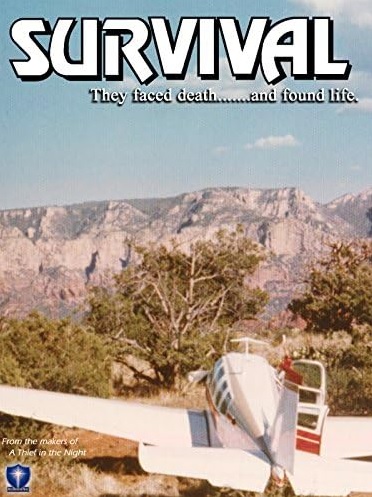The last film in the Thief In the Night series, 1983’s The Prodigal Planet picks up where Image of the Beast left off. Computer technician and post-Rapture Christian David Michaels (William Wellman, Jr.) is on the verge of being sent to the guillotine when he’s rescued by Connie (Terri Lynn Hall). Connie may be wearing the uniform of UNITE and she may have the mark of the beast but she insists to David that she is actually on his side. Not having much choice but to believe her, David joins Connie in a military grade RV. They drive away from Des Moines just as a nuclear explosion takes out the whole city.
After seven years of being ruled over by Brother Christopher and the UN, the world is on the verge of ending. (As the film’s narrators informs us, “Plane Earth is dying and the disease is sin.”) Nuclear war has broken out, destroying cities and killing the majority of the citizens. David is determined to get to Albuquerque, where he and a group of Christians plan to wait for the final judgment. Government agent Jerry (Thom Rachford), who is one of only two characters to have appeared in every Thief In The Night film, is close behind but both he and his men are starting to show the signs of radiation sickness.
(Russell Daughten also returns as the Rev. Matthew Turner, with his apocalypse chart that explains each step of the end of the world. Daughten’s role is small in this one, which is a shame as his grim Santa Claus screen presence was one of the best things about Image of the Beast.)
Along with the remnants of UNITE and a few survivors who have yet to take the mark, the world is also populated by “mutants,” humans whose faces are permanently scarred by the radiation. They dress like monks and stalk empty and deserted city streets. Their goal is to destroy anyone who they believe is responsible for the end of the world. David and Connie rescue a scientist named Linda (Lynda Beatie) and her teenage daughter, Jodi (Cathy Wellman), from a group of mutants. Linda is wracked with guilt because she previously put all her faith in science. Jodi is bitter over how the world has turned out and, initially, she’s upset when David allows a mutant named Jimmy (Robert Chestnut) to join them in their journey.
With The Prodigal Planet, it’s obvious that director Donald W. Thompson had hopes of setting up an epic conclusion for the Thief in the Night films. Not only does the film move the action out of Iowa and into other parts of the country but the film also runs for 127 minutes. (By comparison, A Thief In The Night barely last over an hour.) Unfortunately, most of that running time is taken up with David talking and trying to convert everyone that he meets. On the one hand, considering what’s going on in the film’s world, it makes sense that David would do that. On the other hand, it doesn’t exactly make for exciting viewing. A film that features nuclear explosions and mutants should never be this slow or boring. If the previous Thief In The Night films achieved a dream-like intensity, The Prodigal Planet dutifully plods along. For every scene that works (like an extended sequence in which Linda and Jodi explore a city that isn’t as deserted as it first appears), there are other dramatically inert scenes that encourage the viewer to just about anything other than pay attention to what is happening on the screen.
(It doesn’t help that William Wellman, Jr. — despite appearing to be the only professional actor in this film — displays a bit of a blah screen presence in the role of David. The scene where he tells Jodi that she’s spoiled because she’s pretty fails not because he’s necessarily wrong about Jodi as much as because Wellman can’t make David’s “tough love” approach compelling. He just comes across as being a jerk. The series was better off when the less polished but far more sincere Patty Dunning was the lead character. As for Wellman, he was far more interesting as the morally conflicted national guardsman in The Trial of Billy Jack than he is here.)
Donald W. Thompson hoped to make a fifth Thief In the Night film, one that would feature The War in Heaven and bring the story to its prophesized conclusion. Unfortunately (or not), he was never able to raise the money to do so. And, as such, the saga of UNITE, Brother Christopher, and David Michaels came to a close with The Prodigal Planet.






